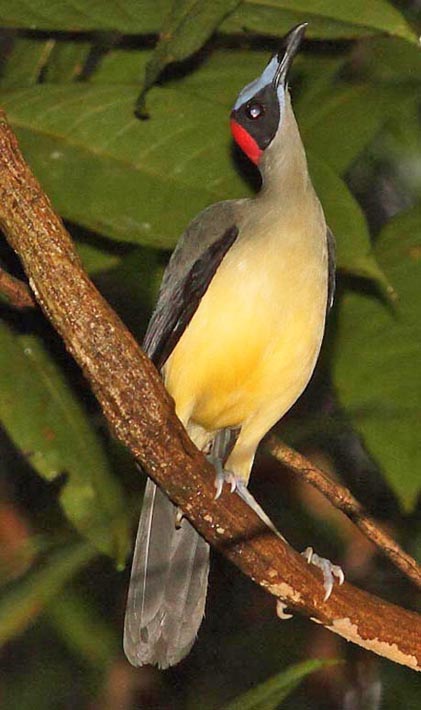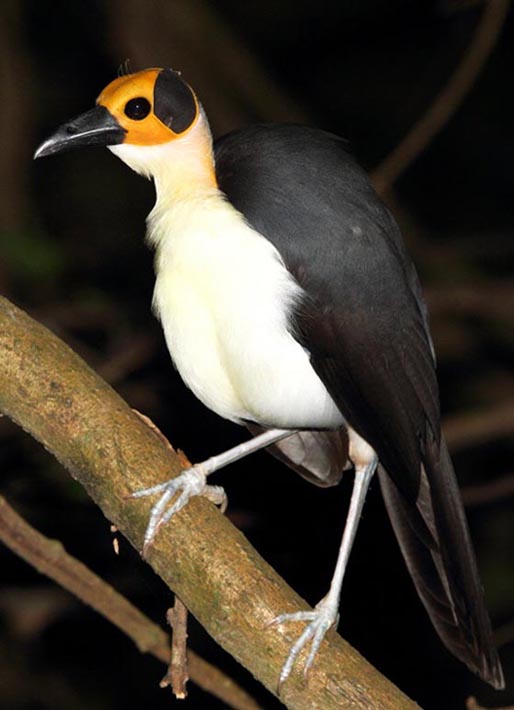| |
ROCKFOWL Picathartidae |
- 2 species in tropical west and central Africa
- DR personal total: 2 species (100%), 1 photo'd
|
 The Rockfowl (or Picathartes) of Africa are strange, elusive and wonderful birds. There are two species: Gray-necked Rockfowl in central Africa near the Gulf of Guinea (left, in a striking photo by Markus Lilje of Rockjumper Tours), and White-necked Rockfowl
of west Africa (below, in a wonderful shot by Adam Riley of Rockjumper
Tours). Both are large, gangly, forest-floor-dwelling passerines that
roost and then breed in caves, where they make mud nests. Their habitat
is humid lowland forest, near streams where mud can be gathered. Their
distribution within their range is very patchy and local, as the
specific requirements must be found there. As they are so unique, and
so patchy and rare in occurrence, and difficult to find, the Rockfowl
have long been considered among the top birds of the African continent. The Rockfowl (or Picathartes) of Africa are strange, elusive and wonderful birds. There are two species: Gray-necked Rockfowl in central Africa near the Gulf of Guinea (left, in a striking photo by Markus Lilje of Rockjumper Tours), and White-necked Rockfowl
of west Africa (below, in a wonderful shot by Adam Riley of Rockjumper
Tours). Both are large, gangly, forest-floor-dwelling passerines that
roost and then breed in caves, where they make mud nests. Their habitat
is humid lowland forest, near streams where mud can be gathered. Their
distribution within their range is very patchy and local, as the
specific requirements must be found there. As they are so unique, and
so patchy and rare in occurrence, and difficult to find, the Rockfowl
have long been considered among the top birds of the African continent.
|
| |
|
| Things
have really changed since I first created a Rockfowl web page back in
1999. At that time it was exceedingly difficult to see either species,
and almost no one had photos of rockfowl in the wild. I marveled at a
photo by Alec Forbes-Watson of an adult White-necked Rockfowl flying to
its nest with food for two begging young is in Colston &
Curry-Kindahl (1986; p. 78). In the 1990s, no one knew how to see that
West Africa species. The countries in which they occurred — Ivory
Coast, Sierra Leone, Ghana, Guinea —were often torn by civil strife and
unsafe for tourists. Then-current information about the taxonomy,
identification, and biology of Rockfowl was summarized in Thompson
& Fotso (1994); it included a color plate of both species by Mark
Andrews [Mark Andrews sent me this wonderful painting (below right) of
a calling Gray-necked Rockfowl in 2001]. There are also sidebars to the
article by Peter Wood & Peter J. Dolton about how to see the two
mythical avians. One spot for Gray-necked was Mt. Kupe, Cameroon, as
summarized in Bowden & Andrews (1994). |
|
|
|
My
effort to see a rockfowl was in Gabon. Our tour group hiked to a cave
used as a nesting and roosting site by Gray-necked Rockfowl in central
Gabon in July 1996 (above left; that's Patrice Christy — Gabon's
premier field ornithologist in the 1980s & 1990s — in the
foreground; the cave is the black area above and left of him). We did
have quick views of two picathartes hurtling out the far left corner. I
look forward to the day when I'm able to enjoy more leisurely views but
this will suffice for now.
Our visit was timed
when there was no breeding activity underway, so we were fortunate that
two individuals were day-roosting in the cave. In hopes that the birds
would return within a couple hours, some of us waited for quite some
time, they did not reappear. It was wonderful to see rockfowl in the
wild, and yet I was concerned that too much disturbance would cause the
birds to abandon the cave. This has happened at some prior sites. We
learned that local villagers fortunately do not generally disturb these
birds, although an occasional one is killed by locals netting bats
(which roost in the same cave in the thousands... one smells bat guano
once you are near the cave). So the birds are disturbed from time to
time on a regular basis by villagers, and this level of disturbance has
not impacted them in decades. |
|
| |
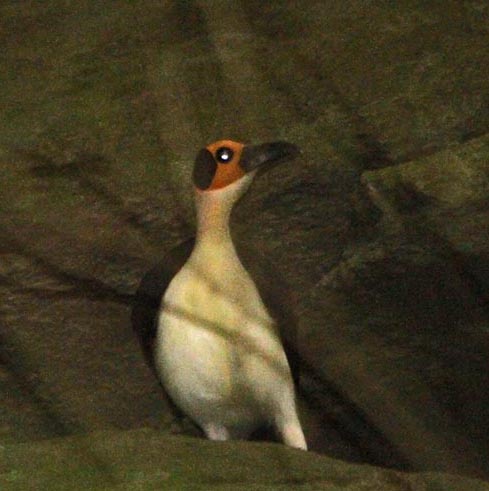 Things are different now. Gray-necked Rockfowl
(below left, another excellent shot by Markus Lilje) remains hard to
find, but Cameroon was more often the visited country, with word that
the Gabon site has declined or may be seasonal. It is still a very
difficult species. Things are different now. Gray-necked Rockfowl
(below left, another excellent shot by Markus Lilje) remains hard to
find, but Cameroon was more often the visited country, with word that
the Gabon site has declined or may be seasonal. It is still a very
difficult species.
In contrast, there are now protected sites in both Ghana and Sierra Leone for White-necked Rockfowl. I saw mine in Ghana (left) and Adam Riley's superb shot was also there (below right).
Adam
Riley writes that, in Ghana, a regularly used cave was known by locals
who used to hunt the birds, but "now that the colony is off limits for
hunting, the population has grown and the village is benefiting
tremendously from entry and guide fees, and a school is being built
courtesy of conservation funds" (from a blog post on 10,000 Birds). It
is still several miles to hike to the colony. The birds have adapted
well to the occasional tour group, and sometimes even seem curious. |
|
|
The
taxonomic position of the Picathartidae was a puzzle for many years. In
past decades they were often tossed into the babbler assemblage, but
its humerus is corvine and early DNA work suggests its closest
relatives were the rockjumpers (Chaetops) of South Africa
(Sibley & Ahlquist 1990). Sibley & Monroe (1990) lumped the
rockfowl with the rockjumpers in a single family, but there is no
longer any support for that position. It was a relief to see that the Handbook of the Birds of the World project, which had initially indicated they would be in the babblers, actually elevated Picathartes
to family status (Thompson 2007). However, they placed them next to the
babblers, which also has no support. In fact, the Rockfowl, the Rockjumpers, and the Rail-babbler
are all ancient lineages at the very base of the Passerida evolutionary
tree, and are more closely related to each other than the latter
branches in the Passerida (Cracraft et al. 2004, Jønsson et al.
2007). Interestingly, Serle (1952) pointed to similarities between
rockfowl and rail-babbler some 60 years ago.
The
two rockfowl are "beautiful, bizarre-looking birds with a bare brightly
coloured head ... they look like a cross between a gamebird and a
crow," said Thompson (2007). I think of them more like a cross between
a ground-cuckoo and a really weird corvid. In fact, a very old name for
the two Picathartes is "bald crow." The sexes are alike. They
are generally silent except for an alarm call and a whistled contact
call between young and parents. The two species apparently forage
primarily on the ground — earthworms and carabid ground-beetles are
important part of their diet — but there are rather few observations
away from their known caves, where they roost and then nest, usually
during the wet season.
I consider the two
rockfowl to be the "best birds" in Africa. Certainly there is high
interest in them by globe-trotting birders, many of whom have tried to
see one or other and have failed. In the first issue of the African Bird Club Bulletin,
two competing professional tour companies took out full page ads about
their African itineraries, one featuring the "Yellow-headed Rockfowl"
and the other the "Gray-necked Picathartes." Obviously there is no
universal agreement on even the English name of these birds, with
"Rockfowl" and "Picathartes" used almost interchangeably, and with the
alternative descriptive specific names attached seemingly at random! I
don't really have a preference, they work equally well. However, as the
Clements' world checklist uses Rockfowl, I am happy to go with that.
|
|
|
Photos: Markus Lilje of Rockjumper Tours photographed the Gray-necked Rockfowl Picathartes oreas at Mt. Korup, Cameroon, in April 2011. Adam Riley, also of Rockjumper, photographed the White-necked Rockfowl P. gymnocephalus
was at Bonkro, Ghana, in Dec 2011; my photo was taken there on 10 Dec
2013. Mark Andrews kindly permitted me to reprint his artwork of a
calling Gray-necked Rockfowl. The habitat photo is from Gabon.
Bird photos © Markus Lilje and © Adam Riley, Rockjumper Tours, used with permission; my shot © D. Roberson ; all rights reserved. Additional photos Don Roberson; artwork © Mark Andrews.
Rockjumper Birding Tours offers worldwide birding adventures, including tours to search for Picathartes in Cameroon, Ghana, and Sierra Leone (as conditions permit). My visit to Ghana was with a Rockjumper tour.
Bibliographic note:
There is no "family book" per se, but a fine introduction to this
family, with some good photos, is in Thompson (2007). Thompson &
Fotso (1995) and Fry et al. (2000) offered additional information.
Literature cited:
Bowden, C. G. R., and S. M. Andrews. 1994. Mount Kupe and its birds. Bull. African Bird Club 1: 13-18.
Colston, P. R., and K. Curry-Lindahl. 1986. The Birds of Mount Nimba, Liberia. British Museum (Natural History), London.
Cracraft,
J., F.K. Barker, M. Braun, J. Harshman, G.J. Dyke, J. Feinstein, S.
Stanley, A. Cibois, P. Schikler, P. Beresford, J. García-Moreno,
M.D. Sorenson, T. Yuri and D.P. Mindell. 2004. Phylogenetic
relationships among modern birds (Neornithes): toward an avian tree of
life. Pp. 468-489 in J. Cracraft and M. J. Donoghue, eds. Assembling the Tree of Life. Oxford University Press, New York.
Fry, C. H., S. Keith, and E. K. Urban. 2000. The Birds of Africa. Vol. VI. Academic Press, London.
Jønsson,
K.A., J. Fjeldså, P.G.P. Ericson, and M. Irestedt. 2007.
Systematic placement of an enigmatic Southeast Asian taxon Eupetes macrocerus
and implications for the biogeography of a main songbird radiation, the
Passerida. Roy. Soc. Lond. Biol. Lett. doe:10.1098/rsbl.2007.0054
Serle, W. 1952. The affinities of the genus Picathartes Lesson. Bull. Br. Ornithol. Club 72: 2-6
Sibley,
C.G., and J.E. Ahlquist. 1990. Phylogeny and Classification of Birds: a
Study of Molecular Evolution. Yale Univ. Press, New Haven, CT.
Sibley, C. G., and B. L. Monroe, Jr. 1990. Distribution and Taxonomy of Birds of the World. Yale Univ. Press, New Haven, CT.
Thompson, H.S.S. 2007. Family Picathartidae (Picathartes), pp. 60 –69 in
Handbook of the Birds of the World (del Hoyo, J., A. Elliott & D.A.
Christie, eds). Vol. 12. Lynx Edicions, Barcelona, Spain.
Thompson, H. S., and R. Fotso. 1995. Rockfowl: the genus Picathartes. Bull. African Bird Club 2: 25-30.
|
|
|
|

 The Rockfowl (or Picathartes) of Africa are strange, elusive and wonderful birds. There are two species: Gray-necked Rockfowl in central Africa near the Gulf of Guinea (left, in a striking photo by Markus Lilje of Rockjumper Tours), and White-necked Rockfowl
of west Africa (below, in a wonderful shot by Adam Riley of Rockjumper
Tours). Both are large, gangly, forest-floor-dwelling passerines that
roost and then breed in caves, where they make mud nests. Their habitat
is humid lowland forest, near streams where mud can be gathered. Their
distribution within their range is very patchy and local, as the
specific requirements must be found there. As they are so unique, and
so patchy and rare in occurrence, and difficult to find, the Rockfowl
have long been considered among the top birds of the African continent.
The Rockfowl (or Picathartes) of Africa are strange, elusive and wonderful birds. There are two species: Gray-necked Rockfowl in central Africa near the Gulf of Guinea (left, in a striking photo by Markus Lilje of Rockjumper Tours), and White-necked Rockfowl
of west Africa (below, in a wonderful shot by Adam Riley of Rockjumper
Tours). Both are large, gangly, forest-floor-dwelling passerines that
roost and then breed in caves, where they make mud nests. Their habitat
is humid lowland forest, near streams where mud can be gathered. Their
distribution within their range is very patchy and local, as the
specific requirements must be found there. As they are so unique, and
so patchy and rare in occurrence, and difficult to find, the Rockfowl
have long been considered among the top birds of the African continent.
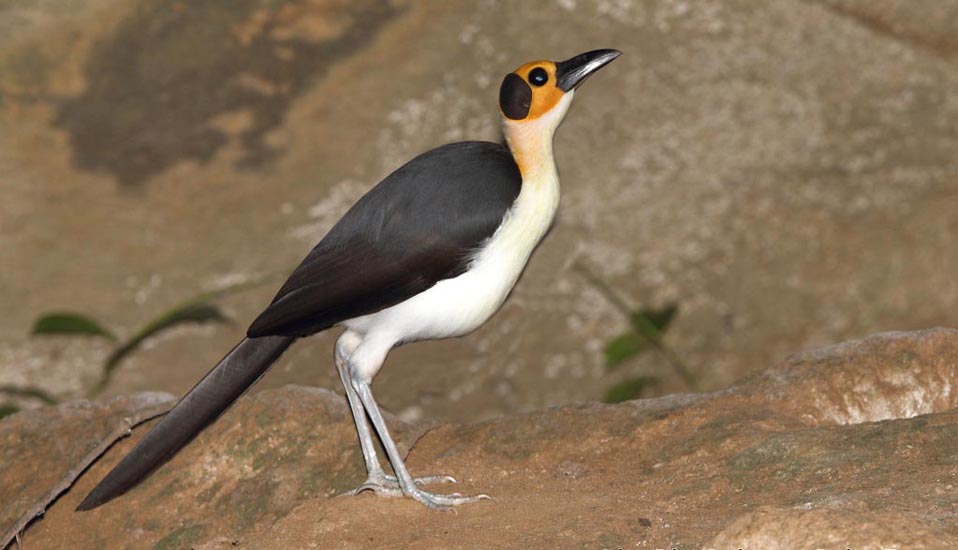

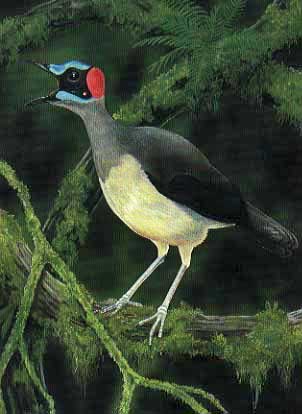
 Things are different now. Gray-necked Rockfowl
(below left, another excellent shot by Markus Lilje) remains hard to
find, but Cameroon was more often the visited country, with word that
the Gabon site has declined or may be seasonal. It is still a very
difficult species.
Things are different now. Gray-necked Rockfowl
(below left, another excellent shot by Markus Lilje) remains hard to
find, but Cameroon was more often the visited country, with word that
the Gabon site has declined or may be seasonal. It is still a very
difficult species. 